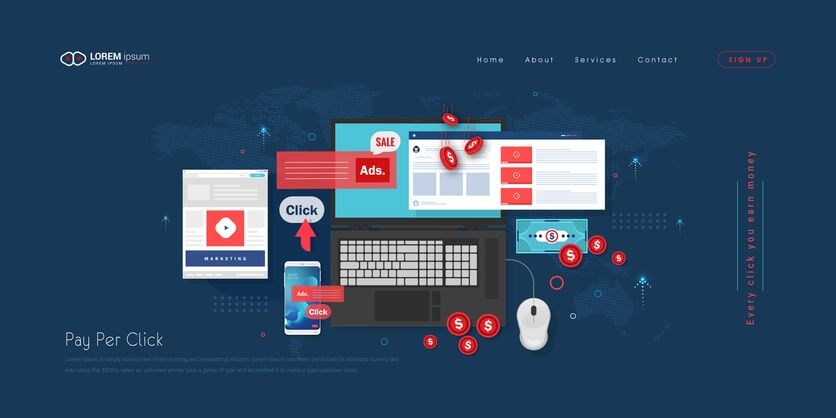Effective Display Advertising to Grow Your Brand
Display Advertising

Put your brand in the spotlight with display ads that do more than just show up, they show off. Salem Surround helps you reach your audience with impact, making every impression count for growth that’s anything but ordinary.
What is display advertising?
Like window displays in a mall or shopping district, display ads offer a quick, visual peek into what a brand has to offer. They’re enticing previews, drawing people in for a closer look. Display advertising uses visual elements like banners, images, and videos to promote your brand across various websites and apps. You’ve likely seen these ads on news sites, blogs, or social media platforms. These ads go beyond text; they leverage eye-catching visuals and engaging formats to capture attention, helping your brand make a lasting impact. Our team strategically positions your ads on websites frequented by your target audience, giving your brand the visibility it deserves. Whether through banner ads or pop-ups, we ensure that your message reaches potential customers in the places they’re most likely to engage.
How does display advertising work?
Display advertising might seem complicated at first, but with the right approach, you can simplify the process. Here are six steps to building a display advertising campaign from start to finish, ensuring every detail is covered for maximum impact.
1. Identifying your target audience
Define who you want to reach by considering demographics, interests, behaviors, and browsing habits. This ensures your ads appear to users most likely to engage with your brand.
2. Set campaign goals and budget
Determine what you aim to achieve with the campaign, such as brand awareness, clicks, or conversions, and allocate a budget that aligns with your objectives.
3. Design engaging ads
Develop visually appealing ads with clear messaging and a strong call-to-action. Choose the best formats such as banners, video, or interactive ads—to capture attention effectively.
4. Choose ad placement and platform
Decide where your ads will appear by selecting relevant websites, social media platforms, or apps. Use ad networks like Google Display Network to reach your audience on sites they visit most.
5. Launch and monitor campaign
Start the campaign and track performance metrics such as impressions, click-through rates, and conversions. Monitoring helps you understand how well your ads resonate with your audience.
6. Optimize based on data
Use insights from your campaign’s performance to make adjustments. A/B test different ad versions, refine targeting, and optimize bids to improve results and achieve your campaign goals.
Types of display ads
There are many types of display ads and each type can have a different format. Some common ad formats are static ads, animated ads, video ads, and interactive ads. Now, let’s take a closer look at these display ad types:
Banner ads
Banner ads are the familiar rectangular ads you see across the top, bottom, or sides of a webpage. These ads are like digital billboards, designed to quietly catch your attention without disrupting your experience. They’re often simple and to the point, using a strong visual and a clear message to encourage you to click through. Banner ads are especially effective for brand awareness, helping brands stay top-of-mind while you browse.
Pop-up ads
Pop-up ads, as the name suggests, are ads that appear over the content you’re viewing, often offering something valuable like a discount, newsletter subscription, or limited-time offer. When done thoughtfully, pop-ups appear at just the right moment and can be surprisingly effective. They’re designed to prompt an action, whether it’s signing up or completing a purchase, and can add real value when they offer something relevant to the user’s experience.
Native ads
Native ads are designed to blend seamlessly with the content around them, making them feel less like ads and more like helpful recommendations. You might see these as suggested articles or products within a webpage, often labeled subtly. Because they’re integrated into the natural flow of content, native ads are less disruptive and can be highly engaging, drawing clicks from users who appreciate the seamless experience.
Interstitial ads
These are full-screen ads that appear during natural transitions on a website or within an app, like moving between pages or levels. Interstitial ads are effective because they grab your full attention before allowing you to continue. They’re best used sparingly, so they don’t disrupt the user experience too much. When timed well, these ads can be very engaging, offering a short, impactful message that encourages interaction.
Retargeting display ads
Retargeting ads are tailored to reconnect with users who have previously visited a site or viewed a product. These ads essentially “follow” users across other sites, reminding them of the products or services they were interested in but didn’t complete a purchase on. Retargeting is a highly personalized strategy that’s very effective for bringing customers back and encouraging conversions, especially for eCommerce. Users who are retargeted are 70% more likely to convert.
When to Use Display vs Search vs Social
-
Display keeps your brand visible and builds demand while people browse.
-
Search ads capture high-intent clicks from people already looking.
-
Social ads amplify content and community where people spend time.
We blend channels so awareness, consideration, and conversion support each other. Link this page to your PPC page, Social Ads page, and CRO or Landing Page page so visitors can explore the full path from impression to sale.
Benefits of Display Advertising
Google Display Ads may sometimes take a backseat to Google Search Ads, but they’re a powerful part of many businesses’ advertising strategies. If you’re wondering about the real impact of display ads and the role they can play in your overall marketing approach, understanding the key benefits can provide valuable insight. Key benefits include:
- Enhanced brand visibility
- Reaching highly targeted audiences
- Access to real-time analytics
Industry Use Cases
-
Ecommerce
Use prospecting to introduce collections and offers, then retarget product viewers with fresh creative. Pair with a product-focused landing page and clean event tracking. -
Local services and multi-location
Prospect in service zip codes, retarget site visitors with location-specific offers, and coordinate messages with your Google Business Profiles. -
Higher education and healthcare
Use content-led creative, geo and interest targeting, and dedicated landing pages that answer common questions and make the next step simple.
If faith-based reach matters, connect with the Salem Display Network and Surround Faith inventory to reach audiences that align with your values.
Ready to Make Every Impression Count?
With Salem Surround, your display ads won’t just be seen—they’ll be remembered. Let’s amplify your brand’s reach with impactful display advertising that captures attention where your audience already is. Get a FREE Snapshot Report & Grow Your Business with insights tailored to your needs. Connect with us, and let’s put your brand in the spotlight!
Frequently Asked Questions
What is display advertising used for?
Display advertising is primarily used to build brand awareness, drive traffic, and encourage specific actions such as sign-ups or purchases. It allows businesses to reach targeted audiences across websites, apps, and social platforms using visually engaging formats like banners, videos, and interactive ads.
How is display advertising different from search advertising?
Search advertising targets users who are actively searching for specific products or services, while display advertising focuses on visually engaging potential customers as they browse online. Display ads appear on websites, apps, and social media platforms, allowing you to reach people even before they begin searching.
What makes a good display ad?
An effective display ad combines strong visuals, clear messaging, and a compelling call-to-action. The design should be attention-grabbing without being intrusive, and the message should be concise and aligned with the audience’s needs and interests.
How does retargeting work with display ads?
Retargeting uses cookies to track users who have visited your website or interacted with your brand. Display ads are then shown to these users as they browse other sites, reminding them of what they viewed and encouraging them to return and take action.
What are the most common types of display ads?
Common types include banner ads, pop-ups, native ads, interstitial ads, and retargeting ads. Each has its strengths, and the best choice depends on your campaign goals and audience behavior.
How do you measure the success of display ads?
Success is typically measured using metrics such as impressions, click-through rates (CTR), conversions, and return on ad spend (ROAS). Real-time analytics allow for ongoing optimization to improve performance.
Are display ads effective for small businesses?
Yes. Display advertising can be scaled to fit different budgets and is especially effective when paired with precise targeting. Even small businesses can build brand recognition and attract customers with well-placed, well-designed ads.
Can display ads target specific audiences?
Absolutely. Display advertising platforms allow targeting based on demographics, interests, behaviors, location, and even the type of device being used. This ensures your ads are seen by the people most likely to be interested in your products or services.
How long should I run a display ad campaign?
The ideal campaign length depends on your goals. For brand awareness, running campaigns for several months builds recognition. For promotional offers, shorter, more targeted campaigns can deliver quick results.
What is the role of AI in display advertising?
AI plays a growing role in optimizing display ads by analyzing user behavior, predicting engagement, and automatically adjusting targeting, bids, and creative elements for better results. At Salem Surround, we use AI-powered tools to improve campaign efficiency and ensure your ads are placed in the most effective locations.

